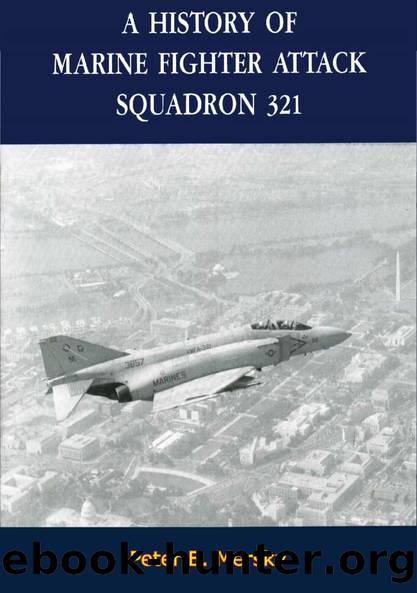A History of Marine Fighter Attack Squadron 321 by Peter B. Mersky

Author:Peter B. Mersky [Mersky, Peter B.]
Language: eng
Format: epub
ISBN: 9781481998192
Google: _4TjlgEACAAJ
Publisher: CreateSpace Independent Publishing Platform
Published: 2013-01-17T02:39:48+00:00
CHAPTER 4âAnacostia to Andrews: Props to Jets
On 30 April 1961, Lieutenant-Colonel Carol Morris, the commanding officer of VMA-321, received the Fleet Admiral Ernest J. King Memorial Trophy for the best Reserve squadron at Naval Air Station Anacostia. The engraved bowl is now on display at Naval Air Facility Washington. Brigadier General Louis B. Robertshaw, Commander, Marine Corps Reserve Training Command, made the presentation during the annual inspection.
At this time, all Reserve activities at Anacostia were transferred to the new Naval Air Facility at Andrews Air Force Base, Maryland. The Department of Defense had actually announced the closing of Anacostia in April 1958 because of the growing congestion among the three major airfields: Anacostia, the Air Forceâs Bolling Field, and the civilian Washington National Airport. The Defense Department proposed moving activities at Anacostia and Bolling to Andrews by 1961. What actually spurred the closure was the TV-2. When one of the jet trainers landed at Anacostia, it was apparent that the stationâs runways were too short to accommodate jets, and could not be lengthened. Later, a target date of 1 June 1961 was established for the move to Andrews, but delayed construction schedules resulting from weather and design changes postponed the move. Meanwhile, VMA-321 continued flying from Anacostia.
VMF-321 had had an early exposure to jets in 1955. After arriving at Cherry Point for training, Major Spurlock was allowed to let one pilot fly the new aircraft. He chose Captain John R. Price, who returned from his flight filled with enthusiasm.
When the relocation to Andrews was completed on 19 October 1961, more than 1,500,000 pounds of equipment, 1,465 officers and enlisted men, and 132 aircraft had made the move. With longer runways available at Andrews, the squadron could now begin the transition to jets. By May 1962, it received the first of its FJ-4B Furies, and on 1 May, it was redesignated Marine Fighter Squadron 321. The Fury was a derivative of the famed North American F-86 Sabre series, and the dash-4 model had been considerably redesigned for naval use.
As the Furies entered service, beginning in May, the squadron spent May and June checking out in TV-2s. Originally, the Marine Air Reserve Training Command planned for Grumman F9F Panthers to replace the Skyraiders, and had sent the squadronâs commanding officer, Lieutenant-Colonel Carol Morris, and Captain Stanley Frost to 2nd Marine Aircraft Wing, MCAS Cherry Point for initial training at VMT-1, the East Coast F9F training squadron. Before the course was finished, however, MARTC selected the Fury instead. But, Colonel Morris and Captain Frost finished the course, with Morris logging 38.6 hours in the F9F.
In 1962, the Marine Air Reserve was organized into the 4th Marine Aircraft Wing (MAW) for mobilization purposes, and VMF-321 was declared a basic unit, and assigned to Marine Aircraft Group 42. VMF-321âs annual training began in late July, with the entire squadron taking the opportunity to check out in the Fury. VMF-321 received the Marine Air Reserve Trophy for the outstanding Marine Air Reserve fighter squadron. Brigadier General Hugh M.
Download
This site does not store any files on its server. We only index and link to content provided by other sites. Please contact the content providers to delete copyright contents if any and email us, we'll remove relevant links or contents immediately.
The Radium Girls by Kate Moore(11921)
100 Deadly Skills by Clint Emerson(4840)
Rise and Kill First by Ronen Bergman(4701)
The Templars by Dan Jones(4627)
The Doomsday Machine by Daniel Ellsberg(4415)
The Rape of Nanking by Iris Chang(4136)
Killing England by Bill O'Reilly(3951)
Hitler in Los Angeles by Steven J. Ross(3900)
Stalin by Stephen Kotkin(3875)
12 Strong by Doug Stanton(3508)
Hitler's Monsters by Eric Kurlander(3268)
Blood and Sand by Alex Von Tunzelmann(3138)
The Code Book by Simon Singh(3073)
Darkest Hour by Anthony McCarten(3070)
The Art of War Visualized by Jessica Hagy(2943)
Hitler's Flying Saucers: A Guide to German Flying Discs of the Second World War by Stevens Henry(2714)
Babylon's Ark by Lawrence Anthony(2619)
The Second World Wars by Victor Davis Hanson(2478)
Tobruk by Peter Fitzsimons(2442)
